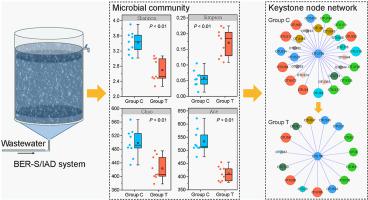Journal of Environmental Management ( IF 8.7 ) Pub Date : 2021-04-02 , DOI: 10.1016/j.jenvman.2021.112473 Minghan Zhu , Minglu Zhang , Yibo Yuan , Peilin Zhang , Shuai Du , Tao Ya , Daying Chen , Xiaohui Wang , Tingting Zhang

|
Ibuprofen has caused great concerns due to their potential environmental risks. However, their removal efficiency and their effects on microbial interactions in bio-electrochemical system remain unclear. To address these issues, a lab-scale bio-electrochemical reactor integrated with sulfur/iron-mediated autotrophic denitrification (BER-S/IAD) system exposing to 1000 μg L−1 ibuprofen was operated for about two months. Results revealed that the BER-S/IAD system obtained efficient simultaneous denitrification (98.93%) and phosphorus (82.67%) removal, as well as an excellent ibuprofen removal performance (96.98%). Ibuprofen had no significant impacts on the nitrate (NO3−-N) removal and the ammonia (NH4+-N) accumulation, but decreased the total nitrogen (TN) and total phosphorus (TP) removal efficiencies. MiSeq sequencing analysis revealed that ibuprofen significantly (P < 0.05) decreased the microbial community diversity and changed their overall structure. Some bacteria related to denitrification and phosphorus removal, such as Pseudomonas and Thiobacillus, decreased significantly (P < 0.05). Moreover, molecular ecological network (MEN) analysis revealed that ibuprofen decreased the network's size and complexity, and enhanced the negative correlations of Proteobacteria and Firmicutes. Besides, ibuprofen decreased the links of some keystone bacteria related to denitrification and phosphorus removal. This research could provide a new dimension for our comprehending of the responses of microbial communities and their interactions to ibuprofen in bio-electrochemical system.
中文翻译:

生物电化学系统中微生物群落的反应及其对布洛芬的相互作用
布洛芬由于其潜在的环境风险而引起了极大的关注。然而,它们的去除效率及其对生物电化学系统中微生物相互作用的影响仍不清楚。为了解决这些问题,将暴露于1000μgL -1布洛芬的,由硫/铁介导的自养反硝化(BER-S / IAD)系统集成的实验室规模的生物电化学反应器运行了大约两个月。结果显示,BER-S / IAD系统获得了有效的同时反硝化(98.93%)和磷(82.67%)去除率,以及出色的布洛芬去除性能(96.98%)。布洛芬对硝酸盐(NO 3 -- N)和氨(NH 4 +-N)积累,但降低了总氮(TN)和总磷(TP)的去除效率。MiSeq测序分析表明,布洛芬显着(P <0.05)降低了微生物群落多样性并改变了它们的整体结构。一些与反硝化和除磷有关的细菌,如假单胞菌和硫杆菌,明显减少(P <0.05)。此外,分子生态网络(MEN)分析显示,布洛芬降低了网络的大小和复杂性,并增强了变形杆菌和Firmicutes的负相关性。。此外,布洛芬减少了一些与反硝化和除磷有关的关键细菌的联系。这项研究可以为我们理解生物电化学系统中微生物群落的反应及其与布洛芬的相互作用提供一个新的维度。


























 京公网安备 11010802027423号
京公网安备 11010802027423号